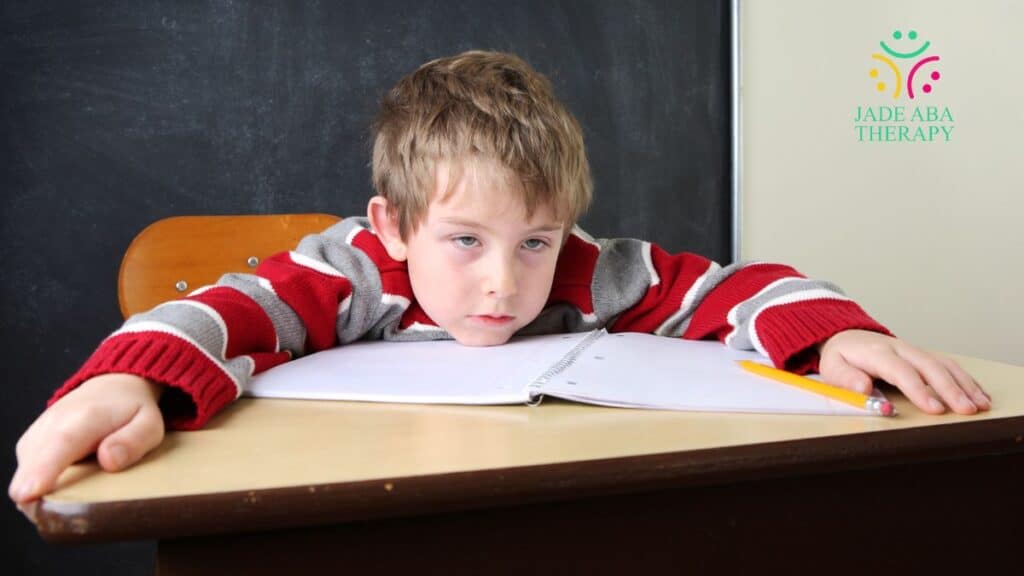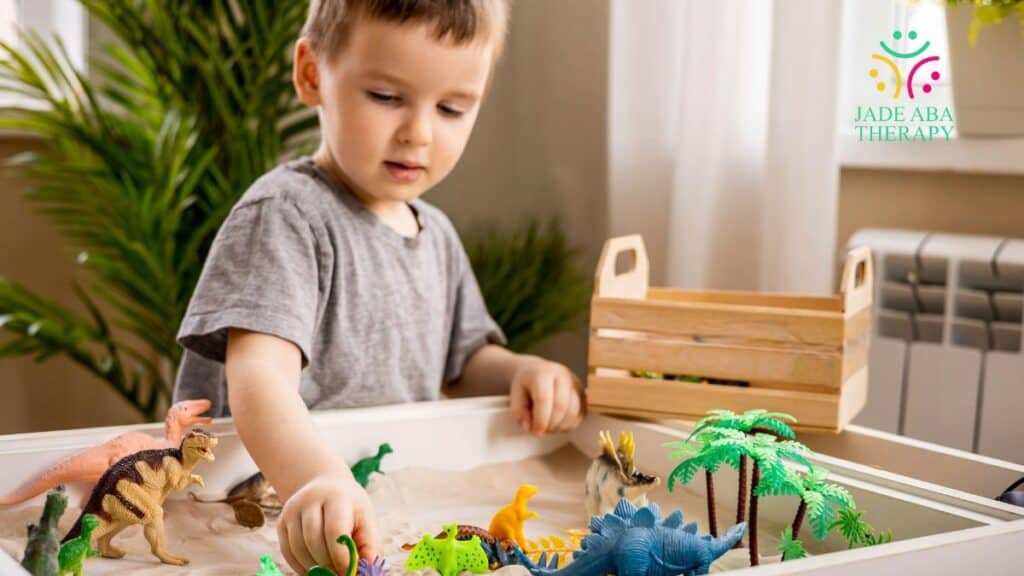Key Points:
- Manage autism understimulation by creating sensory-rich routines with movement, tactile input, and deep pressure.
- Use interest-based tasks, structured breaks, and communication supports to boost engagement.
- Occupational therapy and ABA refine strategies, while caregivers track patterns and adjust input to balance arousal.
Autism understimulation frustrates families because the signs are subtle. A child looks “checked out,” rushes to seek big movement, or craves noise and bright lights when the world feels too quiet.
Understimulation in autism links to hyporesponsiveness to sensory input, low arousal, or plain boredom. The goal is not to remove stimulation but to give the right kind, at the right time, and in the right dose.
Autism Understimulation 101: What It Is and Why It Happens
Understimulation in autism means low arousal or a weak response to input. Ordinary sensory cues may not register, so the body looks for more. That need can show up as:
- Constant motion or pacing
- Chewing or mouthing objects
- Humming or singing
- Craving deep pressure (hugs, squeezes)
- Turning up music or TV volume
It can also look quiet, like zoning out, slow responses, flat affect, or daydreaming during boring tasks.
Understimulation and overstimulation share the same sensory map, which therapists often address through sensory integration therapy. A person might seek strong touch while blocking sound. Sensory state shifts with sleep, stress, hunger, medication, and task demands.
Sensory differences are common in autism. In a U.S. study of 25,627 autistic children, 74% had documented sensory differences. About 13% of children with current ADHD also had autism, which can add boredom or thrill-seeking to low arousal.

Recognizing the Signs & Symptoms of Understimulation in Autism
To deal with autism understimulation, first understand its symptoms of understimulation clearly. These are the red flags that someone is feeling understimulated and in need of more meaningful sensory or cognitive engagement.
Here are common signs of understimulation:
- Restlessness or excessive fidgeting: pacing, tapping, or constant physical motion
- Increased repetitive behaviors or stimming: hand-flapping, spinning, and rocking
- Daydreaming, zoning out, or appearing “checked out” during tasks or conversation
- Difficulty focusing or maintaining attention, especially when tasks are simple or uninteresting
- Sensory-seeking behavior: touching sensory boards or exploring textures, seeking movement (jumping, swinging, etc.), loud or varied sounds
- Feeling bored, unmotivated, or even irritable. In some cases, fatigue or low mood can set in
Sometimes, a person might feel both overstimulated and understimulated at the same time. For example, they may avoid bright lights (overstimulation) but also feel bored because there’s no tactile or movement input (understimulation).
Also, there’s overlap with ADHD: ADHD and understimulation often link because both involve difficulty with sustained attention and a drive for novelty or stimulation.
What Causes Understimulation & Why It’s Hard to Fix Quickly
Knowing what leads to feeling understimulated helps tailor strategies rather than guessing. Some common causes:
- Environments that lack sensory variety: very quiet rooms, few textures, minimal movement or activity.
- Predictable, repetitive routines without variation or challenge. Tasks that are too easy or not engaging intellectually. Approaches such as Pivotal Response Training increase motivation and novelty.
- Limited social interaction: isolation, fewer chances for communication or group play.
- Sensory preferences: if certain senses are underutilized (for instance, touch or movement), the person may not naturally seek them out or caregivers may not realize the need.
- Lack of tools or support for communicating needs, especially if nonverbal or using alternative communication.
These causes make feeling understimulated chronic when not addressed. Also, understimulation is often misinterpreted: people might think a child is “just lazy,” “unfocused,” or “disobedient.” That misunderstanding delays proper intervention.
How to Deal with Understimulation: Practical Tips & Strategies
After recognizing the symptoms and causes, it helps to have a toolbox of strategies. Here are ways to fix understimulation and support someone with autism in becoming more engaged and balanced.
1. Design a Sensory-Rich Environment & Sensory Diet
Creating a sensory diet means planning a mix of sensory-input activities throughout the day to match the child’s or person’s needs.
- Include tactile input: sensory bins, textured fabrics, and safe chewable items, guided by principles from sensory integration therapy.
- Add movement-based activities: swinging, trampoline, obstacle courses, and crawling through tunnels.
- Proprioceptive input: carrying weighted objects, push/pull games, use of weighted blankets or vests.
- Auditory stimulation: music, nature sounds, and sound toys. Vary volume and style.
- Visual and olfactory variation: lights of different brightness or colors, scents (safe ones) in small doses.
Use structured times for these activities but stay flexible. For example, starting the day with movement, mid-morning tactile games, afternoon social or auditory play, and evening calming deep pressure.
2. Use Engaging Activities that Match Interests & Offer Challenge
Understimulation often comes from tasks that are too simple or that someone doesn’t care about.
- Choose learning or play activities tied to the child’s special interests. Models like the Early Start Denver Model use play and interest to sustain engagement.
- Introduce novelty: new textures, games, exercises, or routes outdoors. Even small changes help (change the route for walk, use new materials).
- Gradually increase complexity or challenge. If puzzles are easy, move to ones that require more steps or combine skills.
- Break up long tasks with sensory breaks. Use timers, visual schedules, or reminders to encourage “sensory breaks” so the person can move, touch, etc.
3. Promote Social Engagement & Communication
Feeling understimulated often includes “feeling disconnected.” Social input helps both sensory and emotional engagement.
- Structured playdates with peers who have similar interests. Encourage interactive games that require turn-taking or group sensory play.
- Use communication tools (verbal, AAC devices, and visual supports) to allow the child to express boredom, request stimulation, or say “that feels too little” or “I need something different.”
- Integrate social learning into sensory activities: group music, rhythmic movement, dance, or songs.
4. Use Movement & Physical Activity Regularly
Physical activity serves both sensory and emotional regulation roles.
- Daily exercise: running, biking, swimming. Even walks with variations (different surfaces, hills).
- Playground equipment: swings, slides, and climbing ladders.
- Structured sports or martial arts if the child is interested or can participate.
- Brain breaks: short bursts of jumping jacks, stretching, and dancing between learning tasks.
5. Use Professional & Therapeutic Supports
Some needs may exceed what parents/caregivers can do alone. Supports that help:
- Occupational Therapy to assess sensory profile and build tailored sensory-integration activities.
- Applied Behavior Analysis (ABA) to shape behaviors that seek healthy sensory input, teach self-regulation, and embed sensory strategy into daily routine.
- Speech & Language Therapy or AAC supports to help express wants/needs.
- Psychology or Counseling to address mood, motivation, or internal distress caused by chronic understimulation.
Movement also supports attention and behavior during the day. Reviews show both acute and ongoing physical activity improves cognitive and behavioral outcomes for autistic youth. Build “movement snacks” into the plan to keep arousal in the useful mid-zone.
What to Do When Overstimulation and Understimulation Occur Together
Sometimes people with autism feel overstimulated and understimulated simultaneously. That means in one area of sensory input there’s too much (bright lights, loud noise), while in another area there’s too little (touch, movement, novelty). It can be confusing when behaviors resemble both states: restlessness, distress, avoidance, and seeking input.
To manage this mixed state:
- Tune into which senses need reduction and which need enhancement. For example, wear headphones (reduce loud noise) but put on a weighted vest (increase proprioceptive input).
- Build spaces or times where sensory input can be controlled: a “quiet zone” with calming input and a “play zone” with more sensory stimulation.
- Use visual schedules so the person anticipates transitions from quiet to active and back.
- Use cues or signals (verbal, visual) that let the person say, “I need less of X and more of Y.”
How Parents & Caregivers Can Support Consistently
Consistency helps make strategies effective. Without steady support, fluctuations in sensory input can lead to more distress. Here are ways caregivers can help:
- Observe patterns: when does understimulation seem worst? In the afternoons? After school? Use that info to plan sensory input around those times.
- Involve the child in selecting sensory tools or activities, giving choice increases buy-in and often improves outcomes.
- Keep a toolkit of go-to sensory items (fidget toys, noise-makers, and textured items) so when understimulation hits, you can act quickly.
- Educate other caregivers (teachers, siblings, babysitters) about the signs of understimulation and what helps.
- Adjust expectations: sometimes people expect resting or quiet times to always look calm. It’s okay if a child needs more movement or sensory seeking.

Put It Together: A Sample Daily Flow (Adjust to Fit)
A simple schedule can stabilize arousal while leaving room for preferences. Use this as a template and personalize it.
Morning (20–30 minutes):
- Wake with dim lights → curtains open; 3 minutes of animal walks; chewy protein breakfast.
- Two-minute “engine start” game (mini-trampoline with a count) → 10 deep breaths → dress.
- Backpack carry to door (heavy work) → short, upbeat playlist on the ride.
School day (repeatable blocks):
- Start of block: chair push-ups + visual checklist.
- 12 minutes work → 3 minutes movement → 12 minutes work → “boss level” question.
- Sensory kit available; the student selects one fidget with resistance.
After school (30–45 minutes):
- Outdoor movement or scooter; crunchy snack; 10-minute decompression.
- Homework in two short rounds; interest-based prompt for the first problem in each subject.
Evening (60 minutes before lights out):
- Lower lights, deep-pressure play or burrito wrap, guided breathing, or a quiet story.
- Electronics off on a timer; same bedtime daily to support sleep stability.
Adjust intensity up or down based on behavior afterward. The right dose leaves the child calmer and more focused and not wired.
Frequently Asked Questions
Do stimulants help autism?
Stimulants help ADHD symptoms in autistic people but not core autism traits. Methylphenidate and amphetamines reduce inattention and hyperactivity, though side effects are more common than in non-autistic ADHD. Guidelines list stimulants as first-line for ADHD, with monitoring of appetite, sleep, mood, and heart health.
What is looping in autism?
Looping in autism means perseveration—repeating thoughts, words, or actions beyond usefulness. It includes echolalia, scripting, or motor stereotypies. Clinicians assess whether it regulates, provides sensory input, or manages anxiety, then teach flexible alternatives. Speech and behavioral therapies target triggers and replacement skills.
What is the best mood stabilizer for autism?
No single best mood stabilizer exists for autism. Evidence for valproate, lithium, or lamotrigine is limited and low-certainty. For severe irritability and aggression, risperidone and aripiprazole hold FDA approval and outperform divalproex in trials. Selection depends on target symptoms, comorbidities, and safety.
Turn Understimulation Into Teachable Moments
Families often see steadier mornings, smoother homework time, and faster transitions when the plan aligns inputs, tasks, and breaks. You get clear goals, frequent progress notes, and a team that adjusts supports as skills improve.
Try in-home ABA therapy in Maryland and Virginia if your child needs a plan that blends sensory inputs with skill building across real routines at home and school. Jade ABA Therapy designs practical programs that pair movement, visual supports, and clear teaching to extend time on task and cut friction across the day.
If you want a plan that addresses understimulation in autism while growing communication, play, and daily living skills, reach out to schedule an intake and see how a focused program can help your child move forward.




